
British Columbia is the westernmost province of Canada, situated between the Pacific Ocean and the Rocky Mountains. With an estimated population of 5.2 million as of 2021, it is Canada’s third-most populous province. The capital of British Columbia is Victoria, the fifteenth-largest metropolitan region in Canada, named for Queen Victoria, who reigned over the British Empire at the time of Confederation. The largest city is Vancouver, the third-largest metropolitan area in Canada, the largest in Western Canada, and the second-largest in the Pacific Northwest. In October 2013, Greater Vancouver had an estimated population of approximately 2.5 million. Since 2017, the province has been governed by the New Democratic Party.
The British Columbia Parliament Buildings in Victoria
Because of the many mountain ranges and rugged coastline, British Columbia’s climate varies dramatically across the province.
Coastal southern British Columbia has a mild, rainy oceanic climate, influenced by the North Pacific Current, which has its origins in the Kuroshio Current. Hucuktlis Lake on Vancouver Island receives an average of 6,903 mm (271.8 in) of rain annually, and some parts of the area are even classified as warm-summer Mediterranean, the northernmost occurrence in the world. In Victoria, the annual average temperature is 11.2 °C (52.2 °F), the warmest in Canada.
The annual mean temperature in the most populated areas of the province is up to 12 °C (54 °F), the mildest anywhere in Canada. During winter on the coast, rainfall, sometimes relentless heavy rain, dominates because of consistent barrages of cyclonic low-pressure systems from the North Pacific. While winters are very wet, coastal areas are generally milder and dry during summer under the influence of stable anti-cyclonic high pressure.
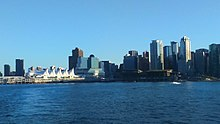
Photo: Canada Place in Downtown Vancouver
BC’s economy is diverse, with service-producing industries accounting for the largest portion of the province’s GDP. The province is agriculturally rich (particularly in the Fraser and Okanagan valleys), because of milder weather near the coast and in certain sheltered southern valleys. Its climate encourages outdoor recreation and tourism, though its economic mainstay has long been resource extraction, principally logging, farming, and mining. Vancouver, the province’s largest city, serves as the headquarters of many western-based natural resource companies. It also benefits from a strong housing market and a per capita income well above the national average. British Columbia has a history of being a resource dominated economy, centered on the forestry industry but also with fluctuating importance in mining. Employment in the resource sector has fallen steadily as a percentage of employment, and new jobs are mostly in the construction and retail/service sectors. It now has the highest percentage of service industry jobs in the west, comprising 72% of industry (compared to 60% Western Canadian average). The largest section of this employment is in finance, insurance, real estate and corporate management; however, many areas outside of metropolitan areas are still heavily reliant on resource extraction. With its film industry known as Hollywood North, the Vancouver region is the third-largest feature film production location in North America, after Los Angeles and New York City.
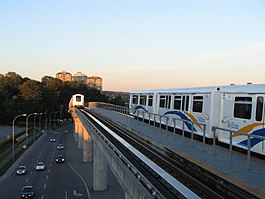
Photo: SkyTrain, Millennium Line
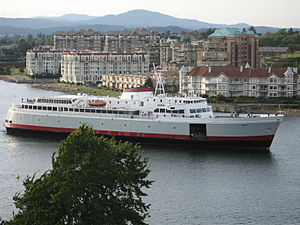
Photo: MV Coho in Victoria Harbor
There are over 200 airports throughout British Columbia, the major ones being the Vancouver International Airport, the Victoria International Airport, the Kelowna International Airport, and the Abbotsford International Airport.
TransLink operates SkyTrain, an automated metro system serving the cities of Vancouver, Burnaby, New Westminster, Surrey, Richmond, Coquitlam, and Port Moody. In 2009, the Canada Line SkyTrain was completed, linking Vancouver International Airport and the city of Richmond to downtown Vancouver bringing the total to three operating metro lines.
Public transit in British Columbia consists mainly of diesel buses, although Vancouver is also serviced by a fleet of trolleybuses. Several experimental buses are being tested such as hybrid buses that have both gasoline and electric engines. Additionally, there are CNG-fuelled buses being tested and used in Nanaimo and Kamloops systems.
BC Ferries provide passenger and vehicle ferry service between Vancouver Island and the Lower Mainland as a cheaper and more reliable alternative to the service operated by the Canadian Pacific Railway and other private operators. It now operates 25 routes among the islands of British Columbia, as well as between the islands and the mainland. Ferry service to Washington is offered by the Washington State Ferries (between Sidney and Anacortes) and Black Ball Transport (between Victoria and Port Angeles, Washington). Ferry service over inland lakes and rivers is provided by the Ministry of Transportation and Infrastructure. Various other coastal ferries are operated privately.
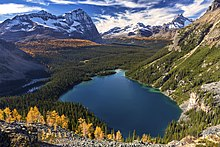
Photo: Odaray Mountain and Lake O’Hara
Given its varied mountainous terrain and its coasts, lakes, rivers, and forests, British Columbia has long been enjoyed for pursuits like hiking and camping, rock climbing and mountaineering, hunting and fishing.
Water sports, both motorized and non-motorized, are enjoyed in many places. Sea kayaking opportunities abound on the British Columbia coast with its fjords. Whitewater rafting and kayaking are popular on many inland rivers. Sailing and sailboarding are widely enjoyed.
Consistent with both increased tourism and increased participation in diverse recreations by British Columbians has been the proliferation of lodges, chalets, bed and breakfasts, motels, hotels, fishing camps, and park-camping facilities in recent decades.
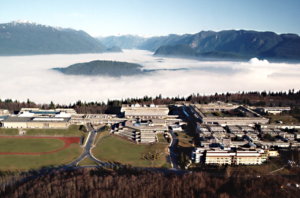
Photo: Simon Fraser University in Burnaby
British Columbia is home to a comprehensive public education system. Instruction is offered in both of Canada’s official languages.
In September 2014 there were 11,000 international students in BC public K-12 schools and about 3,000 international students in other BC K-12 schools
Higher education in British Columbia is delivered by 25 publicly funded institutions that are composed of eleven universities, eleven colleges, and three institutes. This is in addition to three private universities, five private colleges, and six theological colleges. There are also an extensive number of private career institutes and colleges.
Each of the province’s post-secondary institutions sets its own admission requirements. Generally, successful graduation from high school, with the required academic prerequisites, is needed for admission to programs.
Universities in British Columbia
There are eleven public universities and five private universities in British Columbia. Eight of these universities – Capilano University, Emily Carr University of Art and Design, University of the Fraser Valley, Kwantlen Polytechnic University, Trinity Western University, Simon Fraser University, the University Canada West and the University of British Columbia (with the exception of the University of British Columbia Okanagan, the major UBC campus located in the Okanagan Valley) – are in the Metro Vancouver region, the most populated region of British Columbia, and three of them – Vancouver Island University, Royal Roads University and the University of Victoria – are on Vancouver Island. The University of Northern British Columbia houses a main campus in Prince George, with regional campuses in Quesnel, Terrace and Fort St. John. Three public universities, Capilano University, University of the Fraser Valley and Kwantlen Polytechnic University, along with the private Quest University Canada, are primarily undergraduate institutions. Two US based private universities campuses in Vancouver namely New York Institute of Technology and Fairleigh Dickinson University both are in Vancouver primarily for undergraduate and graduate students.
The oldest university in the province is the University of British Columbia, established in 1908, with its newest major campus in Okanagan established in 2005. Five institutions in British Columbia were officially designated as universities on September 1, 2008: Capilano University, Emily Carr University of Art and Design, Kwantlen Polytechnic University, the University of the Fraser Valley, and Vancouver Island University. University enrolment in British Columbia ranges from Quest University Canada with 700 students to the University of British Columbia with 45,484 students.
The biggest provider of online and distance education in BC is Thompson Rivers University, Open Learning. With over 400 individual courses and more than 57 programs available for completion by distance and online learning, students can take a variety of programs such as: adult secondary school completion; certificates and diplomas, including advanced and post-baccalaureate; associate degrees; and bachelor’s degrees. Considering distance students, Thompson Rivers University’s enrolment is 22,036 (8964 of which is distance).
Public colleges | Private colleges |
Douglas College Camosun College Langara College Selkirk College College of New Caledonia College of the Rockies Okanagan College Coast Mountain College Justice Institute of BC | Alexander College Columbia College Coquitlam College Tamwood International College Ashton College Blanche Macdonald Vanwest College |
Source of the majority of Photos and Content of this page: Wikipedia
It is your duty in life to save your dream
AMEDEO MODIGLIANI